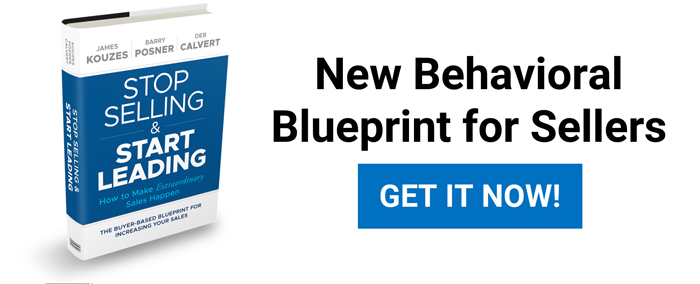B2B Buyer Research: Sales Tactics That Open & Close More Sales
You've got selling skills. You've got the right stack of selling tools. You've got a great product, brand and go-to-market strategy.
So what's missing? Why aren't buyers buying? We asked 530 B2B buyers what they wanted from sellers. Our buyer research pinpointed the behaviors & sales tactics your buyers want to see from you.
B2B Buyer Research Shows Which Sales Tactics Buyers Prefer
This research, a Qualtrics panel study done in partnership with Santa Clara University, started with a simple hypothesis.
The Hypothesis: What if sellers abandoned stereotypical sales behaviors & sales tactics that are off-putting to buyers and replaced them with leadership behaviors? We set out to test our theory that buyers would respond favorably to the 30 behaviors of leaders proven in The Leadership Challenge® to mobilize others toward shared aspirations. Working with authors Jim Kouzes and Barry Posner, we conducted a study with 530 B2B buyers representing all sectors.
A Few Surprises in Our Findings from this B2B Buyer Behavior Research...
Not surprising: B2B buyers rated all 30 behaviors as favorable. The ideal frequency of each behavior would be higher, they said, than the current frequency demonstrated by sellers with whom they choose to do business. What’s more, buyers would be more likely to meet with and buy from sellers who demonstrated these behaviors.
What was surprising, at least to sales professionals, was which of the 30 behaviors buyers rated highest.
Chief among the many takeaways is this: buyers don't want to have words or solutions heaped on them. They don't want to be pitched. They don't want insights that come unilaterally from sellers. They don't want to be overwhelmed with your ideas and answers, no matter how clever or correct they may be.
Nope. They want something different.
According to Research, Buyers Want to be Involved in Creating a Solution
Rather than delivering ready-made insights, buyers want sellers to work with them to brainstorm and co-create insights. Acknowledging and affirming buyer ideas and engaging in two-way dialogue has become increasingly important. That's why sellers benefit from building trust and truly connecting wtih buyers.
Buyers are making a shift predicted more than a decade ago in The Future of Competition : “Consumers will migrate to businesses that allow them to be participants in creating what they want.”
Think about what you do when you go to Chipotle. You make your own, highly customized, just-exactly-what-you-want burrito. A little more guacamole, not quite as many beans, just a dab of corn salsa... Your buyers want the same from you, no matter what you sell. They want to be participants in creating what they want.
 These traditional sales behaviors may be in the way:
These traditional sales behaviors may be in the way:
- Swamping buyers with data that is generated by the sales organization
- Generating solutions and insights internally to deliver back to the buyer
- Assuming about buyer needs based on stale or irrelevant inputs
- Dismissing buyer desire to brainstorm and collaborate (to save time)
- Missing opportunities to affirm buyer ideas and work already done
- Racing to conclusions instead of engaging in meaningful two-way dialogue
- Failing to build trust and, instead, rushing to solve and close the sale
Buyer Research Points Us toward the Behaviors of Leaders
Buyers want to be enabled to act. Enabling Others to Act is one of The Five Practices of Exemplary Leadership®. Those five practices, featured in The Leadership Challenge® body of work, give us an evidence-based framework to lead effectively. Each practice is further defined by six behaviors. Those 30 behaviors are the ones we asked about in our research.
The six behaviors related to enabling others to act clearly resonated with buyers. B2B buyers want sellers to demonstrate these leadership behaviors more frequently. They want their sellers to foster collaboration by building trust and facilitating relationships. They want sellers to strengthen others (including them, the buyers!) by increasing self-determination and developing competence.
Here's what that would look like in practice. To Stop Selling & Start Leading® you would demonstrate behaviors like these:
-
Engaging in two-way dialogue (not one-way diagnostic needs analysis)
-
Involving your buyer more collaboratively in decisions along the way
-
Acknowledging and affirming your buyer's ideas
-
Answering questions fully
-
Brainstorming with your buyer to build ideas and insights together
When you enable your buyer to participate in creating what they want, it dignifies their contribution and ensures their buy in. By sharing control of the process, you will move through it more quickly and get the outcomes you and your buyer desire.

